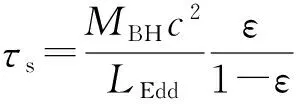活动星系核动量驱动反馈机制的研究
付 艳,张小霞
(中国科学院国家天文台,北京 100012)
活动星系核动量驱动反馈机制的研究
付艳,张小霞
(中国科学院国家天文台,北京100012)
摘要:观测中发现星系中心超大质量黑洞的质量与星系核球速度弥散或星系核球质量之间存在紧致关系。一般认为这类关系是由活动星系核反馈造成的,但是活动星系核反馈过程的微观物理实现并不清楚。甚至活动星系核反馈的提出者(Silk)也对其有效性提出质疑。利用星系的观测数据重新考虑了活动星系核的反馈过程,检验了活动星系核反馈的有效性。收集了一个包括29个星系的样本,通过样本星系的观测数据对它们的势场和由动量反馈而致的气体壳层在势场中的运动做了更准确的研究,发现绝大多数星系的动量反馈是有效的。
关键词:活动星系核反馈;动量驱动反馈;外流;康普顿冷却
星系中心普遍存在超大质量的黑洞[1-3]。观测发现星系中超大质量黑洞的质量MBH与星系核球速度弥散σ或者星系核球质量Mb之间存在紧致关系,即MBH-σ关系或MBH-Mb关系[2,4-12]。这种紧致关系预示着超大质量黑洞与星系相互影响共同演化。人们一般采用活动星系核反馈机制解释MBH-σ(或MBH-Mb)关系。活动星系核反馈机制包括能量驱动反馈机制[13-14]和动量驱动反馈机制[15-17]。能量驱动反馈是指黑洞吸积释放的总能量能够有效地转移为星系中气体整体的热能或动能,并足以使这些气体摆脱星系束缚而逃出星系,这一机制可导致MBH∝σ5。动量反馈则是指由黑洞吸积导致的风或外流将动量传递给周围气体,并扫除这些气体从而终止了黑洞吸积和星系成长,并预言MBH∝σ4。目前尚不清楚活动星系核反馈究竟是能量还是动量反馈机制主导以及反馈机制的具体微观物理过程。
根据星系的黑洞质量和速度弥散测量,文[1]采用等温球模型研究活动星系核反馈的有效性。他们估计了气体从星系中逃出时所需的能量约为Mgcσ(c和Mg分别为光速和星系中气体的总质量),并将其与黑洞吸积释放的总能量ηMBHc2(η=0.1为质能转换或辐射效率)进行对比,发现单纯由黑洞吸积形成的风可能不足以将星系中气体全部吹出星系。因此活动星系核的反馈可能无效。
文[1]采用等温球模型描述星系的质量密度分布和势场分布。等温球分布在靠近星系核球中心位置密度与实际星系的密度分布相比过高,而且在星系外边界密度并不收敛。因而文[1]可能过高地估计了气体的逃逸速度ve(r)。另外文[1]采用(res-r)/ve(res)(res为气体逃逸半径)估计气体逃逸时标τ时,过高估计了气体的逃逸时标。由于星系中气体的逃逸速度随星系中心的距离降低,因而文[1]有可能过高估计了气体逃出活动星系核所需的时间以及所需的能量。总之,对于文[1]计算的ηMBHc2/Mgcσ<1,其核活动的反馈相应未必真的无效。为解释此问题,收集了一个星系样本,每一个样本星系有观测给出的面亮度分布数据。根据这些观测可以得到星系的密度分布轮廓,并估计星系的寄主暗物质晕质量及暗物质密度分布和星系势场。利用这些密度分布,重新考虑了在这些样本星系中的动量反馈过程,并检验了动量反馈过程的有效性。
论文第1节引入观测样本以及有关星系面亮度分布的观测数据[8,10-12,18-22];第2节根据面亮度分布得到样本星系的物质密度分布,并估计暗物质晕的大小和密度分布;第3节重新考虑活动星系核动量反馈过程及其有效性;第4节探讨气体向外扩散时康普顿冷却对活动星系核反馈的影响;第5节讨论影响动量反馈有效性的几个因素;第6节得出结论。
1星系样本
为检验活动星系核反馈的有效性,收集了29个星系的相关观测数据(表1)。这29个星系核区部分(0.1″-10″)均由哈勃望远镜观测。哈勃观测的星系面亮度分布I(R)可以由Nuker law拟合,即
(1)
式中,α、β和γ为Nuker law分布的拟合参数;R为到星系中心的二维投影距离;rb和Ib分别为V波段系面亮度的截断半径和截断半径处的面亮度。当R≫rb时,I(R)∝R-β;当R≪rb时,I(R)∝R-γ。各样本星系V波段的相关拟合参数[8,10-12,18-22]在表1中列出,文中选取的数据采用宇宙学一致模型,即哈勃常数H0为70 km s-1/Mpc,物质相对密度为Ωm=0.27,暗能量相对密度为ΩΛ=0.73。
对于核区之外部分,星系的面亮度分布可以由de Vaucouleurs给出,即
(2)
式中,Re为V波段星系的半光度半径;Ie为Re处星系的面亮度(Re的数据来自文[19])。
为研究活动星系核反馈机制的有效性,需要知道星系中心黑洞的质量。表1中一部分样本星系中心黑洞的质量直接来自测量值,而对于其它没有黑洞直接测量的样本星系则通过MBH-σ关系,即
(3)
给出黑洞质量估计。参数(α,β)在Mbulge≤1011.5M⊙时,取(8.40 ± 0.09, 5.08 ± 0.7);在Mbulge>1011.5M⊙时,取(8.52 ± 0.47, 4.69 ± 2.69 )[10]。
2星系的物质分布和势场分布
星系内的物质包括星系中心的超大质量黑洞、恒星、气体和暗物质晕。若假设星系为球对称分布,除中心超大质量黑洞外,星系内的物质密度分布可表述为
(4)
式中,ρ*(r)为恒星质量密度分布;ρg(r)为气体的密度分布;ρh(r)为暗物质质量密度分布。由于考虑椭圆星系或核球,相对于恒星成分和暗物质成分,气体成分可能并不重要(例如10%ρ*(r)),因此在势场的计算中,忽略气体的贡献。
2.1恒星质量密度轮廓
星系的质量密度分布ρ*(r)可以通过对星系面亮度分布I作积分变换直接得到[23],即
(5)
式中,Υ指星系中恒星的质量与星系光度比;R为到星系中心的投影距离;dI/dR是星系面亮度随R变化的梯度。

(6)
根据(6)式可以求得星系的外半径R0。通过对(5)式进行积分可以得到半径r以内的恒星总质量为
(7)
2.2暗物质质量密度轮廓
星系的暗物质质量密度分布一般可以由Nav-
arro-Frenk-White(NFW)密度轮廓给出[24],即
(8)


(9)
式中,M*,0是恒星特征质量;M1是暗物质晕的特征质量;γ、δ和β均为拟合参数。根据文[26],M*,0、M1、β、δ和γ分别为10.72、12.35、0.43、0.56和1.54。对于表1中M*,total>1011.5M⊙的5个星系,它们都存在于室女座星系团中,其寄主暗物质晕的质量约为Mh~1.2×1015M⊙[27]。

根据星系及其寄主暗物质晕的质量密度分布可以得到它们的势场分布[23]:
(10)

图2展示了只考虑恒星物质或考虑暗物质晕的情况下,星系中不同位置r处的气体或粒子的逃逸速度ve(r),以及这两种情况下星系外半径R0处的逃逸速度ve(R0)。由图2可知,当考虑星系周围暗物质晕时,星系气体的逃逸速度更大,即气体要摆脱星系和暗物质晕的束缚更加困难。
图1星系质量密度分布。红色实线代表星系的恒星质量密度分布,蓝色点线代表包括恒星和暗物质质量密度分布,绿色虚线代表等温球模型下星系质量密度分布
Fig.1Density profiles for those galaxies in Table 1. The red solid lines represent the model only considering stellar mass, the blue dotted lines represent those considering both stellar mass and dark matter mass, and the green dashed lines represent the profiles given by the isothermal model图2星系中气体或粒子的逃逸速度随半径的分布。红色实线和蓝色点线分别代表只考虑恒星物质和考虑恒星物质和暗物质的情况;黑色实心点和黑色空心点分别代表只考虑恒星物质和考虑恒星物质及其寄主暗物质晕的情况,星系外半径R0处的逃逸速度
Fig.2Escape velocitiesat different radii. The blue dotted lines show the results obtained by considering both the contribution from the stars and the dark matter halo to the potential, and the red solid lines show the results obtained by only considering the contribution of the stars to the potential. The open (Full) circles represent escape velocities at the galaxy outer boundaryR0by considering both stars and dark matter halo (or only stars)
3动量驱动反馈
动量反馈可能是导致MBH-σe关系的主导机制[16-17]。由于核活动性输出的动量~fpL(t)/c(或动能)会将星系核心处和星系中的气体挤压至气体壳层(r→r+dr)并向外驱离此气体壳层,这里L(t)是活动星系核的光度,观测表明fp为量级在1左右的常数因子[28],标志外流的动量输出与辐射光子总动量间的比例。若只考虑恒星物质的影响,根据动量守恒定律可有
(11)
M*( (12) 式中,ξ=fp/fg。 星系一般存在于暗物质晕之中,若考虑暗物质晕对气体的引力束缚作用,上述动量方程则应替换为 (13) 式中,Mh( (14) 在核活动触发后,给定L(t)的演化形式,星系核心的气体由于核活动的动量输出推至气体壳层r(t)→r(t)+dr(t)中。此壳层随时间演化可以由上述(12)式和(14)式给出。在核活动结束时,气体壳层的半径达到rf,速度为vf,若vf大于rf处的逃逸速度ve(rf),则认为核活动性的动量反馈足够强以至于可以将星系中的气体驱离星系。若vf 求解(12)式和(14)式得出部分星系中气体能够克服恒星(或包括暗物质晕)的引力束缚所能达到的速度vf和能够到达的位置rf。核活动触发后星系中气体外流,样本星系中部分星系的活动星系核单位时间内输出的动量大于气体受到来自恒星(或包括暗物质)的引力束缚,气体动量会一直增加,当核活动终止时,有些星系气体已成功地逃出星系束缚(rf>R0)(或暗物质晕的维里半径rf>rvir);部分星系的气体动量先增加,活动星系核演化到一定时间,单位时间内来自中心引擎的动量小于来自恒星(或包含暗物质)的引力束缚时,气体动量减少。这些星系中有些在核活动终止时,气体外流的速度vf依然大于气体的逃逸速度ve(rf),气体就能够成功地摆脱星系的束缚,但是这些星系中有些能够逃出恒星的束缚,却逃不出来自暗物质晕的引力束缚。还有部分星系在核活动未终止前,气体壳层已经减速到0,停止向外扩散。 图3展示了核活动终止时,星系的尺度R0或暗物质晕的维里半径rvir与气体壳层到达的位置rf之间的关系,图中只展示了核活动终止后气体外流速度vf不为0的星系。 图4核活动终止时,气体壳层外流速度与其所在处逃逸速度的比值。假定L(t)=LEdd(MBH)=const,(a)为只考虑 4气体冷却 在气体壳层向外扩散的过程中,文[16]指出康普顿冷却对气体壳层的影响可能很重要。冷却非常迅速就有可能导致气体停止向外扩散,当气体壳层向外扩散时会产生激波而被加热,热电子与光子发生康普顿散射,光子吸收电子的能量,使得气体冷却。康普顿散射导致气体冷却的时标为 (15) 其中E是电子的动能量;dE/dt是电子能量耗散速率。若仅考虑简单的单电子逆康普顿散射,其辐射功率[32]为 (16) (17) 式中,v(t)和r(t)是活动星系核演化到t时刻气体壳层的速度和到星系中心的距离;mp是质子质量;me是电子的质量;rkpc是r(t)以千秒差距为单位的距离值;M8=MBH/103M⊙。 核活动演化到t时刻,若对应的康普顿冷却时标tc(t)远小于核活动时标,则气体会被有效地冷却,气体的动量和能量将最终以光子的形式释放,使气体无法逃出星系;反之,若tc(t)远大于核活动时标甚至Hubble年龄,则气体不能被有效冷却,将继续向外扩散,最终当核活动终止时,若气体壳层的速度vf大于逃逸速度ve(rf)时,气体就能够逃出星系。 图5展示了核活动终止时,被激波加速气体外流的冷却时标tc。由图5可知,核活动终止后部分星系中的气体能够逃出星系的束缚,其康普顿冷却时标tc远大于活动星系核演化时标τs,康普顿冷却对这部分星系的动量反馈过程无影响。 图5核活动终止时,气体壳层激波加热后康普顿冷却时标。假定L(t)=LEdd(MBH)=const,(a)为只考虑恒星物质 5讨论 核活动终止后,样本星系中部分星系的气体能够逃出星系(或暗物质晕),部分星系中的气体在核活动尚未终止已经停止向外扩散,与前者对比,后者星系恒星总质量M*,total(或暗物质晕质量Mh)与中心黑洞的质量MBH比值偏大。因此有可能是黑洞质量估计偏小。考虑了黑洞的真实质量稍大于测量给出的中心值(例如为测量值再加上一个标准偏差)这一情况下的活动星系核的动量反馈。 6结果 本文引入星系观测数据重构了星系的恒星质量密度分布和其寄主暗物质晕的密度轮廓,并据此重新考虑了动量反馈过程。研究并讨论了影响动量反馈有效性的几个因素,诸如星系中气体质量与恒星质量之比fg,外流动量输出与中心引擎辐射光子总动量之比fp以及星系周围的暗物质晕引力束缚的影响。发现动量驱动反馈机制在绝大多数星系演化过程中是有效的,从而修正了文[1]得到的动量反馈无效这一结果。 致谢:感谢陆由俊研究员在理论知识和数值计算方面的指导,以及在论文写作中的帮助。 参考文献: [1]Silk J, Nusser A. The massive-black-hole-velocity-dispersion relation and the halo baryon fraction: a case for positive active galactic nucleus feedback[J]. The Astrophysical Journal, 2010, 725: 556-560. [2]Magorrian J, Tremaine S, Richstone D, et al. The demography of massive dark objects in galaxy centers[J]. The Astronomical Journal, 1998, 115(6): 2285-2305. [3]Richstone D, Ajhar E A, Bender R, et al. Supermassive black holes and the evolution of galaxies[J]. Nature, 1998, 395(6701): A14-A19. [4]Ferrarese L, Merritt D. A fundamental relation between supermassive black holes and their host galaxies[J]. The Astrophysical Journal, 2000, 539(1): L9-L12. [5]Gebhardt K, Bender R, Bower G, et al. A relationship between nuclear black hole mass and galaxy velocity dispersion[J]. The Astrophysical Journal, 2000, 539(1): L13-L16. [6]Tremaine S, Gebhardt K, Bender R, et al. The slope of the black hole mass versus velocity dispersion correlation[J]. The Astrophysical Journal, 2002, 574(2): 740-753. [7]Häring N, Rix H W. On the black hole mass-bulge mass relation[J]. The Astrophysical Journal, 2004, 604(2): L89-L92. [8]Gültekin K, Richstone D O, Gebhardt K, el al. The M-σ and M-L relations in galactic bulges and determinations of their intrinsic scatter[J]. The Astrophysical Journal, 2009, 698(1): 198-221. [9]Mcconnell N J, Ma C P, Graham J R, et al. The black hole mass in the brightest cluster galaxy NGC 6086[J]. The Astrophysical Journal, 2011, 728(2): 100-120. [10]Mcconnell N J, Ma C P. Revisiting the scaling relations of black hole masses and host galaxy properties[J]. The Astrophysical Journal, 2013, 764(2): 184-197. [11]Graham A W, Scott N. The M BH-L spheroid relation at high and low masses, the quadratic growth of black holes, and intermediate-mass black hole candidates[J]. The Astrophysical Journal, 2013, 764(2): 151-169. [12]Kormendy J, Ho L C. Coevolution (or not) of supermassive black holes and host galaxies[J]. Annual Review of Astronomy and Astrophysics, 2013, 51(2): 511-653. [13]Cattaneo A. Quasars and galaxy formation[J]. Monthly Notices of the Royal Astronomical Society, 2001, 324(1): 128-140. [14]Tiziana D M, Volker S, Lars H. Energy input from quasars regulates the growth and activity of black holes and their host galaxies[J]. Nature, 2005, 433(7026): 604-607. [15]Fabian A C. The obscured growth of massive black holes[J]. Monthly Notices of the Royal Astronomical Society, 1999, 308: L39-L43. [16]King A. Black holes, galaxy formation, and the M B H-σ relation[J]. The Astrophysical Journal, 2003, 596(1): L27-L29. [17]Murray N, Quataert E, Thompson T A. On the maximum luminosity of galaxies and their central black holes: feedback from momentum-driven wind[J]. The Astrophysical Journal, 2005, 618: 569-585. [18]Faber S M, Tremaine S, Ajhar E, et al. The centers of early-type galaxies with HST. IV. central parameter relations[J]. The Astronomical Journal, 1997, 114: 1771-1796. [19]Lauer T R, Gebhardt K, Faber S M, et al. The centers of early-type galaxies with Hubble Space Telescope. VI. bimodal central surface brightness profiles[J]. The Astrophysical Journal, 2007, 664(1): 226-256. [20]Cappellari M, Scott N, Alatalo K, et al. The Atlas3D project-XV. benchmark for early-type galaxies scaling relations from 260 dynamical models: mass-to-light ratio, dark matter, Fundamental Plane and Mass Plane[J]. Monthly Notices of the Royal Astronomical Society, 2013, 432(3): 1709-1741. [21]Cappellari M, Remid R M, Alatalo K, et al. The Atlas3D project-XX. mass-size and mass-σ distributions of early-type galaxies: bulge fraction drives kinematics, mass-to-light ratio, molecular gas fraction and stellar initial mass function[J]. Monthly Notices of the Royal Astronomical Society, 2013, 432(3): 1862-1893. [22]Cappellari M, Emsellem E, Krajnovic'D, et al. The Atlas3D project-I. a volume-limited sample of 260 nearby early-type galaxies: science goals and selection criteria[J]. Monthly Notices of the Royal Astronomical Society, 2011, 413(2): 813-836. [23]Binney J, Tremaine S. Galactic dynamics[M]. 2nd ed. Princeton: Princeton University Press, 1987. [24]Navarro J F, Frenk C S, White S D M. The structure of cold dark matter halos[J]. The Astrophysical Journal, 1996, 462: 563-575. [25]Duffy A R, Schaye J, Kay S T, et al. Dark matter halo concentrations in the Wilkinson Microwave Anisotropy Probe year 5 cosmology[J]. Monthly Notices of the Royal Astronomical Society, 2008, 309: L64-L68. [26]Behroozi P S, Conroy C, Wechsler R H. A comprehensive analysis of uncertainties affecting the stellar mass-halo mass relation for[J]. The Astrophysical Journal, 2010, 717: 379-403. [27]Fouque P, Solanes J M, Sanchis T, et al. Structure, mass and distance of the Virgo cluster from a Tolman-Bondi model[J]. Astronomy & Astrophysics, 2001, 375(3): 770-780. [28]Pounds K A, King A R, Page K L, et al. Evidence of a high-velocity ionized outflow in a second narrow-line quasar PG 0844+349[J]. Monthly Notices of the Royal Astronomical Society, 2003, 346(4): 1025-1030. [29]Madau P, Haardt F, Dotti M. Super-critical growth of massive black holes from strellar-mass seeds[J]. The Astrophysical Journal, 2014, 784: L38-L41. [30]Page D N, Thorne K S. Disk-accretion onto a black hole. I. time-averaged structure of accretion disk[J]. The Astrophysical Journal, 1974, 191: 499-506. [31]Yu Q, Tremaine S. Observational constraints on growth of massive black holes[J]. Monthly Notices of the Royal Astronomical Society, 2002, 335(4): 965-976. [32]Ishibashi W, Courvoisier J L. The physical origin of the X-ray power spectral density break timescale in accreting black holes[J]. Astronomy & Astrophysics, 2012, 540(4): L2-L5. [33]Oser L, Naab T, Ostriker J P, et al. The cosmological size and velocity dispersion evolution of massive early-type galaxies[J]. The Astrophysical Journal, 2012, 744: 63-71. CN 53-1189/PISSN 1672-7673 Research on the Momentum Driven Feedback Mechanism Fu Yan, Zhang Xiaoxia (National Astronomical Observatories, Chinese Academy of Sciences, Beijing 100012 China, Email: fuyan@bao.ac.cn) Key words:AGN feedback; Momentum driven feedback; Outflow; Compton cooling Abstract:The observations have shown a tight correlation between the mass of supermassive black holes (MBH) at galactic centers and the stellar velocity dispersion (σ), or bulge stellar mass (Mb). It is believed that such relationships are caused by the feedback from the nucleus activity, but in the microscopic physics view the AGN feedback process proceeding is not clear. Recently, Silk & Nusser (2010) suspect the validity of the AGN feedback process by investigating a number of galaxies with observationally determined black hole mass and the stellar velocity dispersion. In the paper, we revisit the study of Silk & Nusser (2010) by considering more details about the galaxy properties. We combine a sample of 29 galaxies. Adopting the observed data of those galaxies, we calculate and reconsider the process of AGN feedback to test the effectiveness of AGN feedback in the potential of those galaxies, their density profile and the potentials, and dark matter. We find that the momentum driven feedback can be effective in most galaxies. 基金项目:国家自然科学基金 (11373031) 资助. 收稿日期:2015-04-27; 修订日期:2015-05-07 作者简介:付艳,女,硕士. 研究方向:活动星系核. Email: fuyan@bao.ac.cn 中图分类号:P142.9 文献标识码:A 文章编号:1672-7673(2016)01-0031-13












